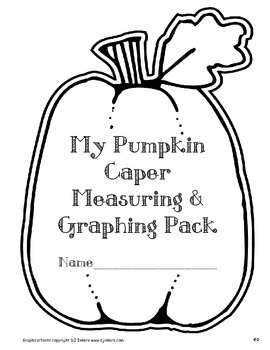The Pumpkin Caper Measuring & Graphing Pack
eo
35 Followers
Grade Levels
1st - 3rd
Subjects
Resource Type
Standards
CCSS2.MD.A.1
CCSS2.MD.A.2
CCSS2.MD.A.3
CCSS2.MD.A.4
CCSS2.MD.B.5
Formats Included
- PDF
Pages
8 pages
eo
35 Followers
Description
This Measurement & Graphing Packet is a fun hands-on way to have your students practice making measurements and graphing on a bar graph. Included in this packet are 8 pages:
1. Cover Page
2. Prediction & Data Page
3. Group Measurement Data Collection Page
4. Class Measurement Data Collection Page
5. Pumpkin Math Question Page
6. Favorite Pumpkin Graph Page
7. Favorite Pumpkin Graph Questions Page
8. Criteria & Standards Page
I use this lesson with my class around Halloween time. This is a 2 part lesson. In the first part, I buy each group a pumpkin to work with. Each group makes predictions and names their group pumpkin. They use various measuring tools (rulers, tape measures, scales, etc.) to make measurements about their pumpkin. After they collect data, they compare it to their predictions. Then we compare all the groups' data on a class chart. Students answer questions about the class' findings. In the second part, we take a poll on each student's favorite pumpkin. Some students may choose their own group's pumpkin as a favorite, or they may choose another group's pumpkin. We take a vote and chart our votes on the board. The students then make a bar graph and answer questions about the class' favorite pumpkin by reading their graph. They also need to create their own number word problem using the information from their graph. Included is a criteria checklist including 2nd grade Math standards that the teacher can use to assess each student or students can use to self assess themselves. Students will love this wonderfully fun activity!
1. Cover Page
2. Prediction & Data Page
3. Group Measurement Data Collection Page
4. Class Measurement Data Collection Page
5. Pumpkin Math Question Page
6. Favorite Pumpkin Graph Page
7. Favorite Pumpkin Graph Questions Page
8. Criteria & Standards Page
I use this lesson with my class around Halloween time. This is a 2 part lesson. In the first part, I buy each group a pumpkin to work with. Each group makes predictions and names their group pumpkin. They use various measuring tools (rulers, tape measures, scales, etc.) to make measurements about their pumpkin. After they collect data, they compare it to their predictions. Then we compare all the groups' data on a class chart. Students answer questions about the class' findings. In the second part, we take a poll on each student's favorite pumpkin. Some students may choose their own group's pumpkin as a favorite, or they may choose another group's pumpkin. We take a vote and chart our votes on the board. The students then make a bar graph and answer questions about the class' favorite pumpkin by reading their graph. They also need to create their own number word problem using the information from their graph. Included is a criteria checklist including 2nd grade Math standards that the teacher can use to assess each student or students can use to self assess themselves. Students will love this wonderfully fun activity!
Total Pages
8 pages
Answer Key
N/A
Teaching Duration
N/A
Report this resource to TPT
Reported resources will be reviewed by our team. Report this resource to let us know if this resource violates TPT’s content guidelines.
Standards
to see state-specific standards (only available in the US).
CCSS2.MD.A.1
Measure the length of an object by selecting and using appropriate tools such as rulers, yardsticks, meter sticks, and measuring tapes.
CCSS2.MD.A.2
Measure the length of an object twice, using length units of different lengths for the two measurements; describe how the two measurements relate to the size of the unit chosen.
CCSS2.MD.A.3
Estimate lengths using units of inches, feet, centimeters, and meters.
CCSS2.MD.A.4
Measure to determine how much longer one object is than another, expressing the length difference in terms of a standard length unit.
CCSS2.MD.B.5
Use addition and subtraction within 100 to solve word problems involving lengths that are given in the same units, e.g., by using drawings (such as drawings of rulers) and equations with a symbol for the unknown number to represent the problem.





